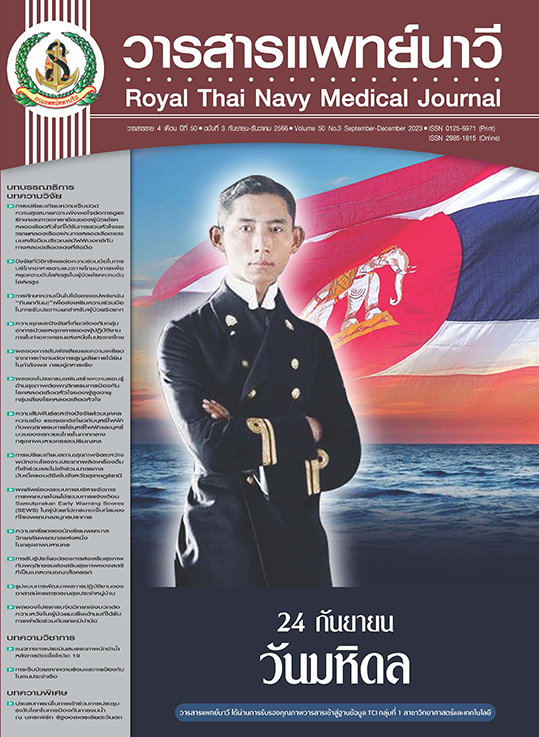The Effect of Health Literacy Promotion Program on Preventive Behaviors among Older Adults at Risk of Coronary Artery Disease
Main Article Content
Abstract
This research was a quasi-experimental, two-group pre and post-test design aiming to study the effects of a health literacy promotion program for the older adults at risk of coronary artery disease. Participants included older people at risk of coronary artery disease who met the specified criteria. Fifty-two participants were recruited and randomly assigned into the experimental group (n = 26) and the comparison group (n = 26). Research instruments included 1) a health literacy promotion program for the older adults at risk of coronary artery disease 2) a heart health care handbook for the older adults 3) a powerpoint presentation on preventive behaviors for coronary artery disease 4) a personal profile recording form and 5) assessment tools for preventive behaviors for coronary artery disease. All instruments were reviewed for content validity by a panel of experts. The contents and assessment tools were validated in terms of Content Validity Index (CVI) at the valve of 0.67 - 1. In addition, instruments for collecting data, which is the preventive behaviors for coronary artery disease test were verified for reliability using Cronbach’s alpha coefficient at the value of 0.82. The experimental group received a health literacy promotion program which was developed from Nutbeam’s health literacy concept while the comparison group received a normal nursing care. Data were collected during the pre-experimental stage and after the experiment using the coronary artery disease prevention behavior assessment form. The data were analyzed using descriptive statistics, independent t-test, and paired t-test.
The results showed that the mean scores of coronary artery disease prevention behaviors of the experimental group in the post-experimental period were higher than the pre-experimental period and were significantly higher than the comparative group (p < .01). From this research results, it suggests that nurses who are working in the hospital should implement the health literacy promotion program in older adults at risk of coronary artery disease groups to promote appropriate coronary artery disease prevention behaviors.
Article Details

This work is licensed under a Creative Commons Attribution-NonCommercial-NoDerivatives 4.0 International License.
References
World Health Organization. Cardiovascular diseases (CVDs). [Internet]. [cited 2021 June 8]. Available from: https://www.who.int/news-room/fact-sheets/detail/cardiovascular-diseases-(cvds).
Virani SS, Alonso A, Benjamin EJ, Bittencourt MS, Callaway CW, Carson AP, et al. Heart disease and stroke statistics-2020 update: a report from the American Heart Association. Circulation 2020;141(9):e139-e596.
Department of Disease Control of Thailand. Elimination of asbestos-related diseases national level 5 year (2018-2021). Bangkok: Emotion Art; 2018. (in Thai).
The Heart Association of Thailand under the Royal Patronage of H.M. Thai acute coronary syndromes guidelines 2020. Samutprakan: Nextstep D-sign; 2020. (in Thai).
Miller CA. Nursing for wellness in older adults. 8th ed. Philadelphia: Lippincott Williams & Wilkins; 2018.
Centers for Disease Control and Prevention. Heart disease and stroke. [Internet]. [cited 2022 September 8]. Available from: https://www.cdc.gov/chronicdisease/resources/publications/factsheets/heart-disease-stroke.htm.
Intarakamhang U. Health literacy: measurement and development. Bangkok: Sukhumvit Printing; 2018. (in Thai).
Nutbeam D. Health literacy as a public health goal: a challenge for contemporary health education and communication strategies into the 21st century. Health Promotion International 2000;15(3):259-67.
Choeisuwan V. Health literacy: concept and application for nursing practice. Royal Thai Navy Medical Journal 2017;44(3):183-97. (in Thai).
Nutbeam D. The evolving concept of health literacy. Social Science & Medicine 2008;67(12):2072-78.
D’agostino RB, Vasan RS, Pencina MJ, Wolf PA, Cobain M, Massaro JM, et al. General cardiovascular risk profile for use in primary care. Circulation 2008;117(6):743-53.
Burns N, Grove SK. The practice of nursing research: conduct, critique, and utilization. St. Louis, Missouri: Elsevier Saunders; 2005.
Trongsakul S, Lambert R, Clark A, Wongpakaran N, Cross J. Development of the Thai version of Mini-Cog, a brief cognitive screening test. Geriatrics & Gerontology International 2015;15(5):594-600.
Jitapunkul S, Kamolratanakul P, Ebrahim S. The meaning of activities of daily living in a Thai elderly population: development of a new index. Age Ageing 1994;23(2):97-101.
Pongvarine N, Associates. Thai geriatric depression scale. Siriraj Medical Journal 1994;46(1):1-9. (in Thai).
Chusri O, Sanprakhon P, Wongwisadkul S. The effects of a self-protective behavior modification program for older adults with chronic disease in urbanized community, Bangkok. Journal of Boromarajonani College of Nursing, Bangkok 2018;34(3):77-88. (in Thai).
Callihan K. Activating the patient: a nurse led coaching intervention to engage health information seeking behaviors using the IDEAL discharge framework and get well network. DNP Projects. 2022:400. https://uknowledge.uky.edu/dnp_etds/400/.
Chiangkhong A. Effectiveness of the development of health literacy through controlled transformative learning due to glycemic control behavior among diabetic patients. [Doctoral Dissertation, Behavioral Science Research Institute]. Srinakharinwirot University; 2018. (in Thai).
Arahung R, Hoontrakul S, Roojanavech S. The effects of health literacy enhancement program on hypertensive prevention behavior of pre-hypertension risk group at a community in Nakhon Pathom province. Royal Thai Navy Medical Journal 2018;45(3):509-26. (in Thai).
Ongkulna K, Pothiban L, Panuthai S, Chintanawat R. Enhancing self-management through geragogy-based education in older adults with uncontrolled hypertension: a randomized controlled trial. Pacific Rim International Journal of Nursing Research 2022;26(4):690-705.


